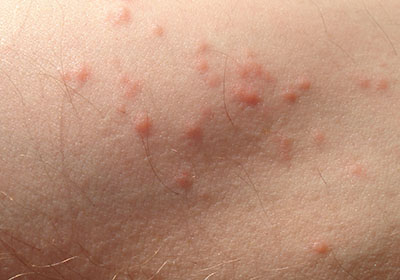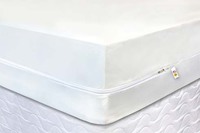Categories
Categories
- Home
- What do bed bugs look like?

Bed bugs are small parasitic insects, roughly the size of an apple seed. Although oval in shape, when viewed from the side, bed bugs are build rather flat. Adult bed bugs can be thinner than the thickness of a normal business card. They are attracted to heat, carbon dioxide and other factors given off by their victims.
They start out as appearing whitish and translucent but take on a rusty red color after taking a blood meal. These insects are elusive, preferring to spend most of their time hiding in undisturbed areas. Bed bugs are well known to be “hitch-hikers” and are often carried unnoticed by their hosts to infest new locations. Bed bugs can be found in places such as planes, mass transit, health care facilities, hotels, resorts, senior citizen facilities, libraries, and other places.
Because of their elusive nature, one of the first signs of a bed bug infestation are the actual bed bug bites people suffer, leaving one to wonder “What do bed bugs look like?”
Adult bed bugs are light to reddish-brown, flattened, oval shaped, and have no developed wings. Preferring to feed on human blood, these insects get their name from their preferred habitat. Bed bugs are mainly active at night and are capable of feeding unnoticed on their hosts.
Bed bugs have six life stages (five immature and one adult stage). They will shed their skins through multiple stages of their life cycle. The discarded outer shells look like clear, empty exoskeletons of the bugs themselves and are often one of the early signs of an infestation. Bed bugs must take a blood meal before molting to the next stage. An adult bed bug may have fed on you or your family as many as 6 times.

It is not necessary for bed bugs to feed every day or every week. Some references indicate bed bugs can survive about one year without feeding. They can “lay in wait” for the next host for surprisingly long periods of time.
Female bed bugs lay about five eggs daily throughout their adult lives in a sheltered location such as mattress seams, crevices in box springs, spaces under baseboards, etc. Bed bug eggs hatch in about 4-12 days. Adult bed bugs live up to 18 months. Bed bugs can survive a wide range of temperatures. Bed bugs will die after 15 minutes of exposure to -32°C (-26°F) and all stages of life are killed by 15 minutes of exposure to 46°C (115°F).
Because of the fact that bed bugs are capable of surviving for extended periods of time without feeding, they can be a difficult pest to manage.
Signs of Bed Bugs
Signs of a bed bug infestation usually start with bite marks appearing on the face, neck, arms, hands and other body parts that are usually itchy. Additional signs of bed bugs may include the exoskeletons of bed bugs after molting, small white eggs, bed bugs in the fold of mattresses and sheets, a sweet musty odor, and rusty-colored blood spots from their blood-filled fecal material that is often excreted on the mattress, box springs, headboards, bed frames, night stands and other places.
- Bite marks on the face, neck, arms and other body parts that are usually itchy .
- Eggs or exoskeletons of the bed bugs.
- Bed Bugs in the fold of the mattresses or sheets.
- A sweet musty odor.
- Rusty-colored blood spots on the mattress or furniture
Bed bugs usually remain close to their hosts, commonly in or near beds or couches. A bed bug couch encasement, such as the Mattress Safe® FurnitureSafe®, is essential for protection to ensure that your living areas remain pest free. Harborage areas can vary greatly to include luggage, vehicles, furniture, and bedside clutter. Bed bugs may also nest near animals that have nested within a dwelling, such as bats, birds, or rodents.
Bed bugs usually remain close to their hosts, commonly in or near beds or couches. Generally speaking, more bed bugs are found toward the head of the bed than towards the foot of the bed.
Bed bugs are an “equal opportunity infester.” They do not discriminate between properties based upon location, type, or quality. Due simply to their nature, logistics, and other factors, every lodging location and multi-family property is subject to bed bug infestation.
If a bed bug infestation is found, a professional pest management company should be contacted for proper control measures. Control practices against these secretive pests must be detailed and extensive. Most of the bed bugs will be located around areas where people rest, but a percentage of bugs will move away from these sites to “hide” in more remote areas. If people do not address these “remote bugs”, an infestation will continue. Along with professional pest management controls, a bed bug certified mattress encasement, such as the Mattress Safe® Ultimate or Superior mattress encasements, will help protect you from bed bug attacks.
How bed bugs spread
With bed bugs becoming a major pest problem in homes, hotels, and businesses across the country, many people are curious about how quickly bed bugs spread. Bed bugs do not fly since they do not have wings. They are able to crawl and move short distances within an infected area, and slowly spread to other rooms in the home or business.
Another way bed bugs move around is by finding their way into purses, backpacks, suitcases, briefcases, clothing, and jackets. Bed bugs rely upon humans to help transport them to new areas and locations where they are free to set up and establish new infestations. In fact, these traveling methods are the number one way people introduce bed bugs into their homes.
Once brought into the home, bed bug infestations take time to grow before they become a major headache. If you were to bring home one single female who has already mated, the new visitor will start to populate the home with new bed bugs. She will lay about 100 eggs over the course of the first month. Since her laying is spread out, by the end of the month there will be roughly 50 or 60 nymphs (developing bed bugs) and 30-40 eggs waiting to be hatched.

By the end of the second month, the adult population will have grown to around 10 breeding adults with about 200 developing bed bugs in various stages, and numerous eggs. At this point, you should start to notice small reddish-brown color dots on your bedding and mattress, and may start to see small dark specks of dirt, as well as other minute particles. Catching bed bugs at this stage is beneficial, as things start to get out of hand by the end of the third month.
The bed bug population explodes during the third month of infestation. By now the colony has grown to over 100 breeding adults, 1,000s of developing nymphs, and 400-500 eggs. In addition, some of the adult bed bugs will start to migrate to other rooms within the home, since they can survive for several months without a meal. If left to continue to grow and expand, the bed bug colony starts to turn into a major infestation.
Within six months of introducing the original pregnant female bed bug into the home, you could be facing infestations in every room of the home. Populations by this point will have soared to well over 8,000 breeding adults, 100,000s of developing nymphs, and 50,000-60,000 eggs waiting to hatch. Knowing how bed bugs spread and populate new areas, you can clearly see why prevention and early detection are vital to keep your home or business bed bug free.
You can protect your bedding, mattresses, and box springs, and furniture in the home, with bed bug certified encasements. These protective barriers stop bed bugs from getting into your pillows, mattresses, box springs, and furniture, should you accidently introduce a bed bug into the home. Mattress Safe® offers a full line of bed bug certified, waterproof and non-allergenic encasements to protect you and hour home.
Portions of content provided by: Entomologist Paul J. Bello, PJB Pest Management Consulting, LLC. - Author of “The Bed Bug Combat Manual”
Mattress Safe® Quality You Can Trust... Service You Deserve®
Mattress Safe® Product Features | Video (1:52)
The Mattress Safe® product collection includes quality mattress and box spring encasements and protectors for any bed in your home. Featuring our soft luxurious fabric, Mattress Safe® encasements are bed bug certified to protect against bed bugs. Mattress Safe® products are waterproof, breathable, fire retardant, and soft to the touch.
Easy Care and Installation Instructions | Video (0:56)
Products by Mattress Safe® are used daily around the world for bed bug protection, allergy relief and waterproof protection. Mattress Safe® products are handmade of long-lasting materials that stretch to fit. Our products are specially designed for ease of installation. Installation instructions are provided with each product.
Why Mattress Safe® Is Bed Bug Certified | Video (1:13)
Mattress Safe® mattress protectors and encasements are your first line of defense against bed bugs, fluids, stains, bacteria and mold. Mattress Safe® encasements are the only products on the market that are bed bug certified. Don't settle for lesser encasements that claim "bed bug protection". Get the proven gold standard: Mattress Safe® Bed Bug Certified.
 Loading... Please wait...
Loading... Please wait... 
